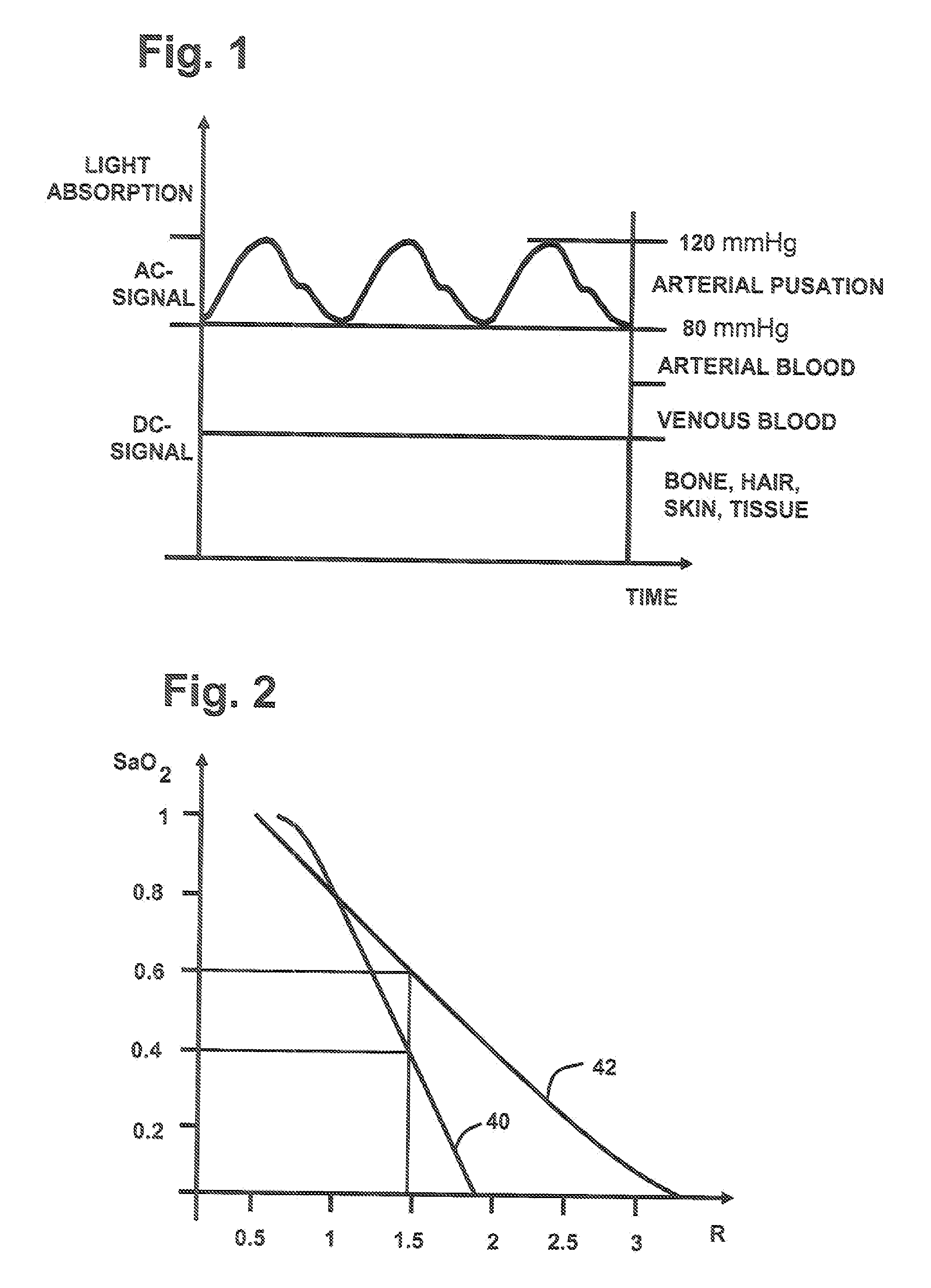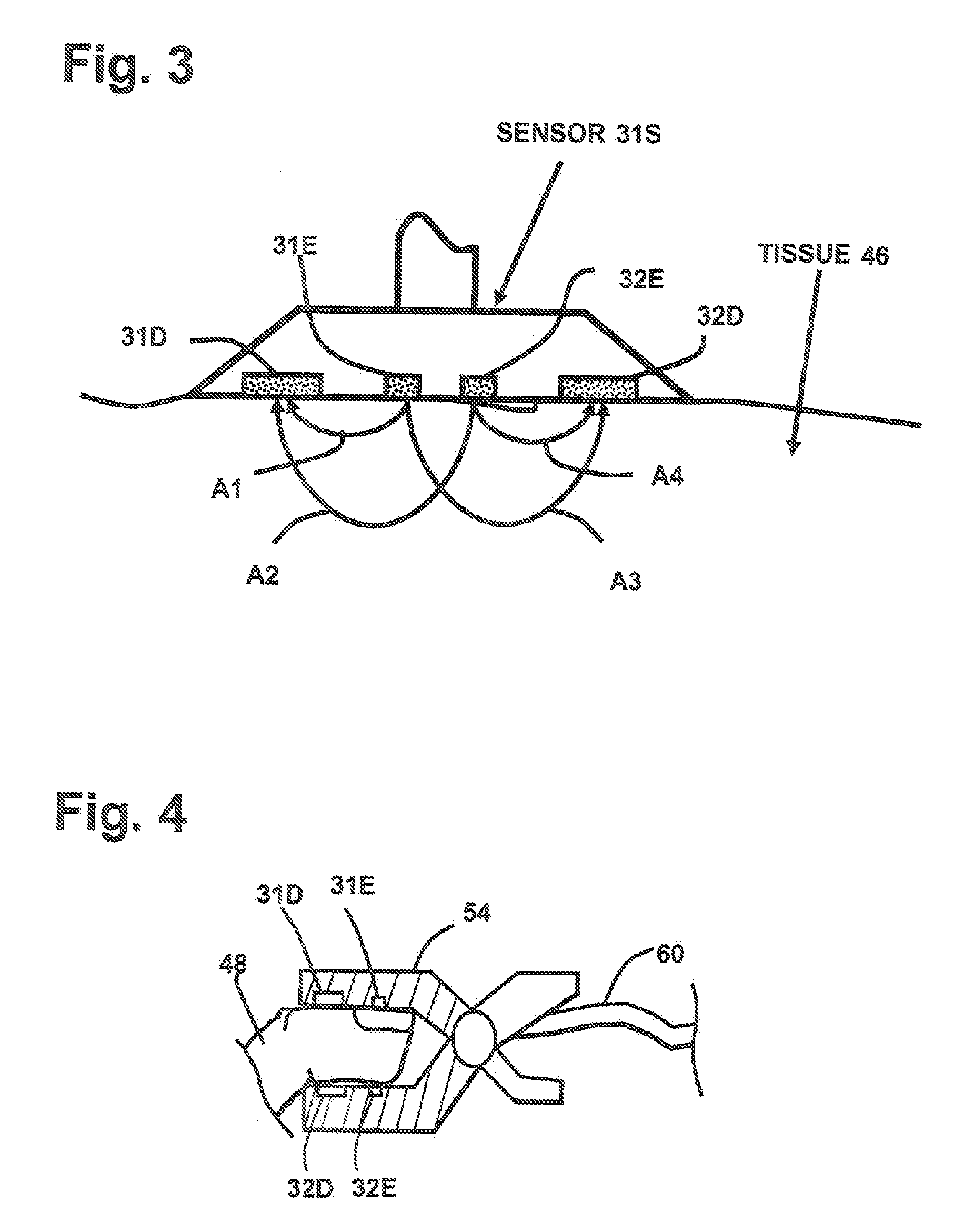Tissue Oximetry Apparatus and Method
a technology of tissue oximetry and oximetry, which is applied in the field of tissue oximetry apparatus and method, can solve the problems of complicated and expensive calibration of optical instruments, insufficient pulse oximetry to monitor critically ill patients, and insufficient diagnostic information for critically ill patients, so as to improve the precision of measured output variables and eliminate influences on calibration
- Summary
- Abstract
- Description
- Claims
- Application Information
AI Technical Summary
Benefits of technology
Problems solved by technology
Method used
Image
Examples
example 1
[0056] The sensor 31S shown in FIG. 3 is used to determine the arterial oxygenation and the mixed venous blood oxygenation of tissue with improved precision. Equation (2) is used to provide a measurement variable R′ for the arterial oxygenation. For each of the emitters 31E and 32E, three wavelengths are defined. Initially, two measurement wavelengths w0=940 nm and w2=660 nm are selected. Using equation (4) the third wavelengths w1 is about 788 nm. Wavelength w1=805 nm is chosen because it is close to the calculated third wavelength and is additionally at an isobestic point of the blood absorption spectrum. The next step is to determine the resulting light attenuation LA for each of the three wavelengths w0, w1 and w3:
LAw1=LA(A3w1)+LA(A2w1)−LA(A1w1)−LA(A4w1) eq. (5)
LAw2=LA(A3w2)+LA(A2w2)−LA(A1w2)−LA(A4w2) eq. (6)
LAw3=LA(A3w3)+LA(A2w3)−LA(A1w3)−LA(A4w3) eq. (7)[0057] where LA(Axwy) is the logarithm of received light intensity in the detector related to light arrow Ax at wavelengt...
example 2
[0067] In FIG. 4 finger clip sensor 54 is shown with the two emitters 31E, 32E and the two detectors 31D and 32D. The benefit of the finger clip sensor is that it is easy to apply. Equivalent to sensor 31S in FIG. 3, four representative light paths between the two emitters and the two detectors are possible so that all calculations according example 1 can be performed in order to calculate the output variables R′ and Rv′ as a measure for mixed venous and arterial oxygenation in the finger 48. The corresponding calculations can also be performed using sensor of FIG. 9. The difference here is the alternative form of detectors 35D and 36D, which are able to increase detected light intensity due to an enlarged, concentric detector area.
example 3
[0068]FIG. 5 shows a multidimensional calibration of SaO2 vs. R1 and R2. R1 and R2 can be calculated according (1) by selecting two wavelengths pairs where for the first wavelengths pair the wavelengths wm1=660 nm and wm2=910 nm is chosen and for the second wavelengths pair wm3=810 nm and wm2=910 nm. The second wavelengths pair is less sensitive towards arterial oxygenation and is used to compensate errors due to optical tissue parameter variations. In order to guarantee that the multidimensional calibration delivers improved precision in presence of varying tissue parameters, it is important to select exactly the correspondent calibration which is specified for a distinct wavelengths set and a distinct detector emitter distance. Therefore additional information has to be coded to the selected sensor. The tissue oximeter device can read out this information and use the appropriate calibration. The coding of information can be achieved for example by a resistor implemented in the LED...
PUM
 Login to View More
Login to View More Abstract
Description
Claims
Application Information
 Login to View More
Login to View More - R&D
- Intellectual Property
- Life Sciences
- Materials
- Tech Scout
- Unparalleled Data Quality
- Higher Quality Content
- 60% Fewer Hallucinations
Browse by: Latest US Patents, China's latest patents, Technical Efficacy Thesaurus, Application Domain, Technology Topic, Popular Technical Reports.
© 2025 PatSnap. All rights reserved.Legal|Privacy policy|Modern Slavery Act Transparency Statement|Sitemap|About US| Contact US: help@patsnap.com



